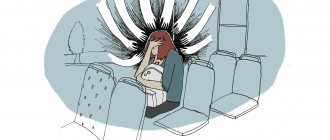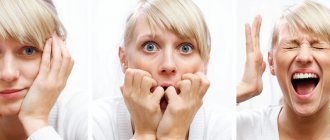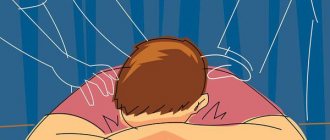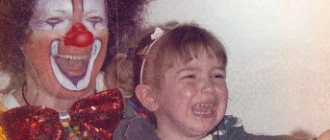Anxiety disorder is a group of neuroses that includes generalized anxiety disorder, panic disorder and social anxiety disorder, as well as a number of specific phobias. Anxiety disorder is one of the most common mental illnesses. According to various estimates, every fifth person has experienced anxiety and/or depression to some degree.
Mixed anxiety and depressive disorder
- Mixed anxiety-depressive disorder is a rather controversial phenomenon, and not all existing diagnostic classifications include it. It is not that its existence is not recognized, and it is sometimes considered a depressive disorder with secondary anxiety characteristics rather than a single disorder.
- Mixed symptoms of anxiety-depressive disorder include anxiety and depression, but neither is clearly predominant. Neither is each of sufficient intensity to justify a separate diagnosis.
- The disorder presents with a mixture of relatively mild symptoms that are seen quite frequently in primary care, and its prevalence is high in the general population.
- The combination of depressive and anxiety symptoms causes significant impairment in the affected person's functioning.
IMPORTANT! However, those who oppose this diagnosis argue that the presence of this diagnosis prevents clinicians from distinguishing true depressive disorders from true anxiety disorders and takes away the time needed to obtain a complete psychiatric history of the patient.
We recommend reading the article
"Free psychological help in Russia"
Find out about
how depression progresses
Mechanism of occurrence and course of the disease
Anxiety neurosis can be fueled by some objective reasons: information about layoffs, an aggressive leadership style, difficult relationships with colleagues or relatives, emotional articles in the media or television programs. Normally, all these events occupy a person’s thoughts for a short time.
But sometimes strong emotional stress, deep-seated emotional drives (obsessive, aggressive, sexual) cause constant painful multi-day thoughts on the topics: if there is a dismissal in our country, will I be fired, how to behave if the boss is rude to me, what to do if in the country a war, famine, a coup will begin... These thoughts, which have no specific reason, completely occupy attention, are considered from all sides, a person constantly makes supposed plans and fictitious dialogues. This is how the neurosis of fear and anxiety arises and develops under the influence of psychological factors.
The cause of the disease can also be physiological factors - hormonal changes (including age-related, in pregnant women, etc.), pathologies in the endocrine system (adrenal glands, which affect hormonal levels, thyroid gland), excessive intellectual or physical stress, diseases of a general nature. Anxiety neurosis occurs in acute form, but more often it is chronic. It can arise as a consequence of an attack of sudden intense fear or develop gradually. Regardless of the mechanism of occurrence and severity, the disease worries for a long time, accompanied by a distinct feeling of internal tension and discomfort, as well as symptoms of a physiological nature.
When is mixed anxiety-depressive disorder diagnosed?
To diagnose it, it is necessary to record the presence of low-intensity symptoms of anxiety and depression. In addition, there should be some autonomic symptoms such as tremors, palpitations, dry mouth and abdominal pain.
Please note: Some preliminary research has shown that mixed anxiety-depressive disorder is rarely diagnosed by general practitioners. However, it is possible that this lack of recognition only reflects the lack of an appropriate diagnostic label for these patients.
Maintenance pharmacological therapy
A meta-analysis showed that long-term use of SSRIs (6–12 months) was effective in preventing relapse (odds ratio for relapse = 0.20).
Relapse after 6-18 months of duloxetine, escitalopram, paroxetine and venlayaxin XR was observed in 10-20% of cases, compared with 40-56% in the control group. Continuing pregabalin and quetiapine XR also prevents relapse after 6-12 months.
Long-term RCTs have shown that escitalopram, paroxetine and venlafaxine XR help maintain benefit over six months.
Anxiety-depressive disorder symptoms
- The clinical manifestations of this disorder combine symptoms of anxiety disorders and symptoms of depressive disorders.
- In addition, symptoms of autonomic nervous system overactivity, such as gastrointestinal discomfort, are common. This is why patients often seek medical help first.
DSM - criteria for mixed anxiety-depressive disorder
- The Diagnostic and Statistical Manual of Mental Disorders (DSM) puts forward a number of criteria for diagnosing this disorder. However, as we already mentioned, this is for research purposes only.
- An essential characteristic of this disorder is persistent or recurrent dysphoria (decreased mood) that lasts for at least 1 month. This condition is accompanied by additional symptoms of the same duration, including at least four of the following:
- Difficulty concentrating or memory, sleep disturbances, fatigue or lack of energy.
- Acute irritability.
- Permanent and intense anxiety.
- Increased tearfulness or feelings of hopelessness, pessimism about the future, worthlessness and low self-esteem.
- Increased vigilance, anticipation of danger.
These symptoms cause significant clinical discomfort or impairment in social, work, or other important activities.
- On the other hand, mixed anxiety-depressive disorder should not be diagnosed when symptoms are due to direct physiological effects of certain substances or other medical conditions. Or if the person has at any time been diagnosed with major depressive disorder, persistent depressive disorder, anxiety disorder, or generalized anxiety disorder.
- This diagnosis is also inappropriate if criteria for any other anxiety or mood disorder are simultaneously met, even if they are in partial remission.
- It is also necessary that the spectrum of symptoms cannot be consistent with another mental disorder. Much of the primary information about this disorder comes from primary care centers, where the disorder is more common and likely also has a higher prevalence among outpatients.
The main symptoms of anxious depression are:
- a feeling of anxiety that has no specific cause and almost does not leave the patient during the day;
- increased anxiety, tearfulness, irritability, inadequate alarm reaction to any unplanned events,
- low mood, feeling of hopelessness, constant expectation of something bad, internal tension, inability to relax;
- difficulty concentrating and maintaining attention (difficulty concentrating), memory deterioration, decreased performance;
- insomnia, fatigue, weakness, feeling of being on the verge of a breakdown.
In addition to mental symptoms, anxious depression has a lot of physical manifestations: trembling, palpitations, dizziness, pain in various parts of the body, sensations of heart failure, lack of air, difficulty breathing, tightness in the chest, “coma” in the throat, frequent urge to urinate, diarrhea , sexual dysfunction.
Often, patients begin to treat anxious depression on their own, resorting to taking over-the-counter medications available to them (phenibut, afobazole, glycine, Sonmil, Corvalol). At first, taking these medications brings some relief from anxiety symptoms, but the improvement is short-term and requires an increase in the doses of medications taken.
The next common step in self-medication for anxiety depression is daily intake of sleeping pills in increasing dosages (zopiclone, Somnol, Sonnex, Sonnat) or daily drinking of alcohol to relieve tension and alleviate anxiety symptoms. This kind of “treatment” leads to further disturbances in the metabolism of GABA and dopamine, aggravates the course of the disease, and leads to the formation of dependence on alcohol or sleeping pills. An attempt to stop taking alcohol or sleeping pills causes severe anxiety, which the sick person is unable to resist.
Important! Anxious depression requires long-term specialized treatment and does not go away on its own!
Anxiety-depressive disorder with panic attacks
Very often, anxiety-depressive disorder is accompanied by panic attacks. First, let's figure out what panic attacks are?
These are sudden attacks of fear and anxiety, which are accompanied by symptoms characteristic of stress or fear. Symptoms of a panic attack:
- Dizziness and lightheadedness
- Tachycardia
- Feeling of depersonalization
- Excessive sweating
- Feeling of suffocation, “lump in throat”, difficulty inhaling or exhaling
- Pain behind the sternum, in the heart area
- Nausea, diarrhea, stomach pain
- Fear of dying or going crazy, doing something scary, for example, jumping off a roof, throwing yourself in front of a car
A panic attack is usually a natural result of increased anxiety. When a person is in a tense, depressed state for a long time, the psyche cannot stand it and goes into a tailspin, and the person experiences an acute sense of panic. A panic attack itself does not last long (usually no longer than 10 minutes) and is not dangerous to health, however, it is such a traumatic event that a person is afraid of its repetition, and subconsciously or consciously begins to avoid the events, places, circumstances where the panic attack occurred.
Having a panic attack further aggravates anxiety and depression, thus creating a vicious circle when anxiety reinforces panic and vice versa. And everything together gets worse and prevents the person from functioning normally, anxiety becomes a constant emotional background that accompanies the patient every day, and panic attacks occur with some increasing frequency.
Symptoms
The clinical manifestations of anxious depression are extremely diverse and vary depending on the character traits and ideological views of the patient. Common features of TDR traditionally include:
- Unfounded fears . Patients are not able to reasonably explain why in the near future they “must” die, go bankrupt, witness the Apocalypse, and so on.
- Personal changes . Patients with TDD demonstrate previously absent nervousness, tearfulness, constant anxiety, and a desire to play it safe in everything. Also in most cases there is a noticeable decrease in self-esteem.
- Narrowing the circle of interests . The scope of interest is limited to the subject of the phobia: for example, when they are afraid of losing their job, patients constantly study job advertisements “just in case,” and when they are afraid of getting sick, they study medical encyclopedias. Former interests and hobbies lose their former attractiveness.
- Sadness of mood . The predominant mood pattern of patients with TDD can be described as sadness, fatigue, or detachment. The conversation is dominated by the theme of the purposelessness of any activity or life itself.
- Somatic disorders . Patients experience tachycardia and pain in the heart, digestive and stool disorders, high blood pressure, general weakness and rapid fatigue, lack of sexual desire, headaches and dizziness, insomnia, a feeling of suffocation, frequent urination, sweating, tremors, muscle tension and convulsions.
What is the impact of mixed anxiety-depressive disorder?
- The coexistence of major depressive disorder with an anxiety disorder is very common. Two thirds of patients with symptoms of depression also have overt symptoms of anxiety. One third of these may meet diagnostic criteria for panic disorder.
- Some researchers report that 20% to 90% of all patients with anxiety disorders have episodes of major depressive disorder. These findings suggest that the coexistence of depressive and anxiety symptoms that do not meet diagnostic criteria for depressive or anxiety disorders is very common.
- However, there is currently no official epidemiological data on mixed anxiety-depressive disorder. But some researchers have estimated that the prevalence of this disorder in the general population is 10%, although in primary care it becomes 50%. More conservative estimates suggest a prevalence of 1% in the general population.
Causes of anxiety-depressive disorder
Four lines of research suggest that symptoms of anxiety and depression are associated with the following identified causes.
1. First, several researchers have found similar neuroendocrine causes of depressive and anxiety disorders. They include:
- cortisol response to adrenocorticotropic hormone
- growth hormone response to clonidine
- thyroid-stimulating hormone
- prolactin response to thyrotropin-releasing hormone
2. Second, a number of researchers have presented data that identify hyperactivity of the noradrenergic system as a significant factor in the occurrence of depressive and anxiety disorders in some patients
Specifically, these studies have shown that patients with depressive or anxiety disorders who are actively experiencing an anxiety crisis have high concentrations of the norepinephrine metabolite MHPG in their urine, plasma, or cerebrospinal fluid.
As with other anxiety-depressive disorders, serotonin and GABA may also be involved in the origin of mixed anxiety-depressive disorder.
3. Third, many studies have shown that serotonergic drugs such as fluoxetine and clomipramine are useful in the treatment of both depressive and anxiety disorders.
4. Finally, several family studies have provided evidence suggesting that anxiety and depressive symptoms are genetically transmitted, at least in some families.
Publications in the media
Emotions constitute an integral component and manifestation of human life. There are only two types of positive emotions: joy and interest. Negative emotions have a wider spectrum than positive ones and are divided into biological (anxiety, fear, suffering, anger and their derivatives) and social (shame, guilt, fear of losing one’s self). A special place among them is occupied by anxiety, which is one of the most ancient evolutionary mechanisms. Its biological significance is that it, as an analogue of an active-defensive reaction, provides the body with preparedness for action in a situation of stress. According to R. May [7], “anxiety is fear in a situation where a value is under threat, which, according to a person’s feeling, is vitally important for the existence of his personality.” In this context, anxiety is natural, adequate, and useful. However, under a number of objective and subjective conditions, anxiety becomes excessively expressed, loses its adaptive nature and is considered pathological (
). Transforming from normal to pathological, anxiety becomes the basis for the formation of anxiety disorders (AD).
Etiopathogenesis and epidemiology of TR
Currently, during times of stress and overload, the prevalence of TD in the population is very high [1, 10]. According to foreign literature, at one time 9% of the world's population suffers from some kind of TR, and almost 25% of people suffer from TR throughout their entire life.
The biological and psychological prerequisites for the formation of TR are considered [2]. Psychological aspects of etiopathogenesis are presented within the framework of various psychological theories. In particular, psychoanalytic theory views anxiety as a signal of the emergence of an unacceptable, forbidden need or impulse that prompts the individual to unconsciously prevent its expression. From the standpoint of behaviorism, anxiety and, in particular, phobias initially arise as a conditioned reflex reaction to painful or frightening stimuli. Cognitive psychology focuses on erroneous and distorted thought patterns that precede the onset of anxiety.
Biological theories take the biological criterion, i.e., the specific state of the brain substrate, as the basis for defining the concept. In this paradigm, any TR is considered as a consequence of cerebral pathological changes, the identification of which is associated with further improvement of diagnostic technologies. In particular, studies of the bioelectrical activity of the brain of patients with TD show differences in the spatial-frequency characteristics of the electroencephalogram (EEG) in individuals with increased levels of anxiety [3, 5]. A study of the level of cerebral metabolism suggests that the basis of the brain support for reactive anxiety is a system whose most stable links are cerebral structures such as the superior parietal associative cortex, the parahippocampal gyrus, the thalamus and caudate nucleus, and the amygdala [2, 12].
The peculiarity of the modern approach to the study of anxiety is the idea of its multifactorial nature, based on the recognition of the unity of the biological, psychological and social components of anxiety.
Classification of anxiety disorders
Existing classifications of TD involve the formation of independent rubrics based on the understanding of anxiety not as a syndrome, but as a separate diagnostic unit. Anxiety and TD are considered in the two most widely used diagnostic systems - ICD-10 and the American DSM-IV-TR.
ICD-10 does not use the traditional differentiation between neuroses and psychoses, which was used in ICD-9. However, the term "neurotic" is retained in the title of the large group of disorders F40-F48 "Neurotic, stress-related and somatoform disorders."
The Diagnostic and Statistical Manual of Mental Disorders DSM-IV-TR (2000) used the term “neurosis” to describe anxiety disorders before the classification was reissued in 1980. However, in the future, a trend of increasing clinical “fragmentation” of TD began to take place, which was reflected in later classification systems of behavioral and mental disorders.
Clinical characteristics of anxiety disorders
The group of TD includes several rather heterogeneous diseases, connected by one common feature - a high level of anxiety, which is persistent in nature, may or may not be limited to any specific circumstances (fixed or unfixed, personal and situational).
Clinically, TR is manifested by mental and somatic (vegetative) symptoms, an important distinguishing feature of which is their polysystemic nature.
The most common mental manifestations of TR are:
- fears (worry about future failures, feelings of excitement, difficulty concentrating, etc.);
- worrying about little things;
- irritability and impatience;
- feeling of tension, stiffness;
- fussiness;
- inability to relax;
- feeling nervous or on the verge of a breakdown;
- inability to concentrate;
- memory impairment;
- fast fatiguability;
- fears;
- obsessive thoughts, images.
Autonomic (somatic) manifestations of anxiety include:
- sweating, cold and wet palms;
- dry mouth;
- feeling of a “lump” in the throat;
- feeling of lack of air;
- muscle tension and pain;
- nausea, diarrhea, abdominal pain;
- dizziness;
- fainting state;
- decreased libido, impotence;
- muscle tension and pain;
- cardiopalmus;
- hot or cold flashes.
A characteristic property of anxiety is not only the anticipation of a particular danger, but also the motivation to search for and specify this danger, which leads to the formation of certain syndromes. The formation of one or another clinical syndrome, i.e., one or another variant of TR, depends on the path followed by the specification (realization) of anxiety.
Characteristics of the main variants of anxiety disorders
Generalized anxiety disorder (GAD) (F41.1) is characterized by anxiety that is generalized and persistent, not limited to any specific environmental circumstances, and does not even occur with a clear preference in those circumstances (i.e., is “unfixed”).
To make a diagnosis, primary anxiety symptoms must be present for at least six weeks. Most often they serve in this capacity:
- restlessness, fussiness, or impatience;
- fast fatiguability;
- disorder of concentration and memory;
- irritability;
- muscle tension;
- sleep disturbance.
Diagnostic criteria for GAD are less clear than for other variants of GAD, and are rather based on the principle of exclusion. According to most researchers, GAD does not represent a single diagnostic category, but rather reflects a special disturbing phenomenon that occurs with different diagnoses.
The remaining TRs, classified under other headings and subcategories, are essentially determined by the above criteria (most of them or only part) and additional criteria that determine the specifics of a particular TR.
The main feature of panic disorder (F41.0) is periodically recurring panic attacks that occur spontaneously, suddenly, without any visible connection with external stimuli (“like a bolt from the blue”), last 5–30 minutes and are accompanied by symptoms such as shortness of breath, palpitations , dizziness, choking, chest pain, trembling, increased sweating and fear of dying or going crazy. Attacks often occur in a situation where patients are restricted in their freedom of movement or in a room from which they cannot escape and where they cannot get help.
Panic disorder is often accompanied by agoraphobia. Currently, this term is interpreted more broadly than before, and includes fear not only of open spaces, but also of any situations from which it is not possible to immediately get out and return to a safe place. Although agoraphobia is considered a separate disorder, it often serves as a defense mechanism for panic disorder: by staying at home or leaving it only with an accompanying person, sufferers thereby avoid stress, reducing the likelihood of an attack.
Phobic anxiety disorder (F40) clinically manifests itself as overvalued fears that are not justified by a specific threat or do not correspond to its level of significance.
The following are the characteristic properties of phobias:
- expressed and persistent or unreasonable fear associated with the presence or expectation of a specific object or situation;
- immediate phobic reaction to an alarming stimulus;
- the patient’s awareness of the excessiveness and irrationality of fear;
- avoidance of phobic situations;
- pronounced distress associated with awareness of the phobia.
The topics of phobias are varied. One of the most common types of phobias - nosophobia (fear of illness, for example, cancerophobia) - is often provoked by the illness of someone you know. Even a thorough medical examination rarely brings relief.
Agoraphobia (F40.0) is specific to the fear of being in a crowd of people, in a public place, or on any trip, especially on your own. As mentioned earlier, agoraphobia can accompany panic attacks, but can also occur without them.
Social phobia (F40.1) - severe fear of being the center of attention or fear of behaving in a way that causes embarrassment or humiliation in certain situations, such as socializing or eating in public, public speaking, meeting familiar faces in public, visiting public restrooms, being in small groups (e.g., parties, meetings, classrooms), etc.
The defining criterion for specific (isolated) phobias (F40.2) is fear within a strictly limited situation or strictly defined objects (heights, snakes, spiders, airplane flights, etc.). As with social phobias, avoiding significant situations in some cases helps patients adapt quite successfully to everyday life.
Obsessive-compulsive disorder (F42) includes compulsions, which often lead to the formation of obsessive actions and rituals (compulsions). Obsessions are ideas, thoughts, or impulses that persistently and persistently pursue a person and that are perceived as painful and unpleasant, such as blasphemous thoughts, thoughts about murder, or thoughts about sex. They are characterized by the following signs:
- perceived as intrusive and inappropriate;
- are not the result of excessive worry about real problems;
- accompanied by an unsuccessful desire to suppress, avoid, ignore them, or neutralize them with other thoughts or actions;
- are recognized by the patient as a product of his own psyche.
Compulsivity is a repetitive, goal-directed, and intentional behavior that occurs as a reaction to compulsions in order to neutralize or prevent psychological discomfort.
Examples include obsessive thoughts about dirt and pollution, leading to compulsive washing and avoidance of “polluting” objects, pathological counting, and compulsive checking, such as repeatedly checking that the gas is off, or returning to the same street to make sure no one is there. crushed, etc.
Post-stress anxiety within post-traumatic stress disorder (F43.1) develops after life-threatening situations or disasters (military operations, nuclear power plant accident, car accident, fire, flood, rape). Characterized by persistent painful memories, increased excitability, irritability and outbursts of anger, sleep disturbances and nightmares, including pictures of the experienced situation, feelings of loneliness and mistrust, a feeling of inferiority, avoidance of communication and any activities that may remind of the events that occurred.
Mixed anxiety and depressive disorder (F41.2) is diagnosed when the patient has symptoms of both anxiety and depression, but neither one nor the other is clearly dominant or severe.
Within the framework of specific personality disorders (F60) (it should be remembered that pronounced personality disorders are psychopathy familiar to the Russian-speaking reader), anxious (“avoidant”, “avoidant”) personality disorder (F60. 6). To some extent, it resembles a sensitive type of psychopathy, which was not always distinguished in Russian classifications. From early childhood, patients are characterized as timid, shy people with low self-esteem. An exaggerated fear of arousing even a slight critical attitude leads them to avoidant behavior.
In its clinical picture, dependent personality disorder (F60.7) is very close to the anxious type. It, like the previous one, was also borrowed from the DSM and was absent from classical Russian and German psychiatry. Self-doubt, fear of displaying any noticeable reactions (especially sexual and aggressive) are combined with expressed anxiety, fear of being abandoned by a significant person.
Features of the manifestation of anxiety in childhood are:
- prevalence of obsessive-phobic disorders;
- more pronounced somatization of anxiety;
- pronounced behavioral disorders: limited contact, fussiness, restlessness, aggressiveness;
- self-doubt, low self-esteem;
- constant need for adult support;
- the presence of specific variants of anxiety disorders in children.
Specific TDs of childhood are presented in the heading F93 “Emotional disorders of childhood.” Most of them are essentially exaggerations of normal trends in the process of development, rather than qualitatively new phenomena. An example is separation anxiety disorder in childhood (F93.0). Such children do not develop skills of independent behavior and the fear of separation acquires exaggerated proportions. Anxiety in a child can take the following forms:
- persistent, unrealistic fear of misfortune that could happen to the main person in his immediate environment, or fear that his parents will leave him and not return;
- an unrealistic fear that some untoward event will separate the child from the person for whom great affection is felt;
- refusal to go to sleep alone or away from home for fear of losing a significant person;
- recurring nightmares about separation;
- reappearance of somatic disorders in situations related to separation;
- recurrent distress (anxiety, crying, irritation, apathy, withdrawal, etc.).
The Pediatric Phobic Anxiety Disorder rubric can only be used for developmentally specific fears that meet the criteria of the F93 rubric:
- onset at a developmentally appropriate age;
- the degree of anxiety is excessively expressed and causes a clear decrease in social adjustment;
- anxiety is not part of a more generalized disorder.
Childhood social anxiety disorder (F93.2) is used only for disorders that occur before age 5 years and do not correspond to typical age-specific presentations. Noteworthy is the pronounced difference between behavior at home and in non-family social situations, which is accompanied by problems of social functioning.
Treatment of Anxiety Disorders
Experience with patients suffering from TD inevitably leads clinicians to the conclusion that an integrated approach combining psychotherapy, psychopharmacotherapy and social-environmental influence is maximally effective (
).
The main method in a complex therapeutic complex for TR is psychotherapy [4, 11]. Currently, a psychotherapist has a large arsenal of tools at her disposal, ranging from simple ones that solve the problem of symptomatic improvement to complex ones aimed at resolving the patient’s internal conflicts. Most psychotherapy regimens are based on the assumption that anxiety is caused by an exaggerated assessment of the threat or an incorrect interpretation of one's own state of increased activation. In this case, either the external danger is overestimated or one’s own abilities to cope with it are underestimated. Anxious fears and a feeling of helplessness arise, in which increased attention is paid to one’s internal state. Increased alertness leads to a narrowing of attention and a decrease in its concentration, as well as to violations of self-control and correct response. The most important goal of psychotherapy is to gradually bring patients to an awareness of the essence of their psychological conflict and then to a gradual modification of previous inadequate patterns and attitudes and, ultimately, the development of a new, more harmonious and flexible system of views and relationships, more mature adaptation mechanisms, restoration of self-control and adequate response. The content of the main psychotherapeutic methods effective in working with anxiety disorders is given in
.
All of the above methods are equally effective for various types of TR, however, it is worth noting that certain techniques are more preferable and, in a certain sense, specific for specific forms of TR (
).
Psychopharmacotherapy plays a special role in the treatment of TR (
). Currently, there is a rich arsenal of anti-anxiety drugs that can influence not only mental, but also somatic manifestations of anxiety.
The formation of anxiety is based on an imbalance of certain mediators: serotonin, norepinephrine and GABA. Anti-anxiety drugs mainly realize their effect through these mediator systems. Among GABAergic anxiolytics, the leading place is occupied by benzodiazepine tranquilizers. The main advantages of benzodiazepine anxiolytics are the rapid and real achievement of a therapeutic effect. Among the disadvantages of treatment with benzodiazepines, the following should be mentioned: “recoil” syndrome (rapid resumption or transient increase in symptoms after discontinuation of the drug), the risk of addiction and the formation of drug dependence, impaired cognitive functions (attention, concentration, memory), and impaired coordination. Therefore, benzodiazepine drugs should not be taken for longer than 2–4 weeks.
In connection with the above “benzodiazepine” problems, a new generation of non-benzodiazepine anxiolytics is being widely introduced into clinical practice. These include, in particular, blockers of histamine H1 receptors: tofisopam (Grandaxin), which has an anxiolytic effect, is a psychovegetative regulator, and also does not have a sedative and muscle relaxant effect, and hydroxyzine (Hidroxyzine, Atarax), which has a rapid onset of effect, absence of addiction and drug dependence, does not impair cognitive functions, has antipruritic and antiemetic effects.
Other non-benzodiazepine anxiolytics include the azapirone drug buspirone (Spitomin) and Afobazole (prevents the development of membrane-dependent changes in the GABA receptor).
Tricyclic antidepressants, selective serotonin reuptake inhibitors (SSRIs), and dual-acting antidepressants act on anxiety through the serotonergic systems.
The first-line drugs for the treatment of anxiety disorders are benzodiazepine tranquilizers and SSRIs; tricyclic antidepressants and non-benzodiazepine anxiolytics are considered second-line drugs.
In some cases, a positive effect in the treatment of anxiety is achieved with the use of antipsychotics - thioridazine (Sonapax), sulpiride (Eglonil), tiapride (Tiaprid), etc. However, it should be remembered that when prescribing antipsychotics, weakness, decreased blood pressure, menstrual irregularities, weight gain, colostrum secretion, decreased libido.
Beta-adrenergic blockers (such as propranolol and atenolol) are especially effective when the autonomic component of TR is pronounced, as they block the physical symptoms of chest pain, throat constriction and shortness of breath without having a sedative (relaxing) effect.
In some cases, psychotropic drugs may be poorly tolerated by patients due to side effects, which ultimately neutralizes their therapeutic effectiveness. Official herbal preparations, which have significantly fewer side effects, can be considered as an alternative therapy or used to enhance the effectiveness of prescription drugs. The main indication for the use of this category of drugs is short-term subsyndromal or “undeveloped” (mild) anxiety disorders.
Among the herbal medicines used by clinicians to treat subthreshold anxiety, the drug Novo-Passit has become widespread, which has shown its effectiveness, the possibility of use in a wide variety of age groups [6, 8], the absence of any side effects, high anxiolytic activity and, finally, , which is very important, its availability. The active components of the drug are dry extracts of medicinal plants with pronounced sedative activity (hops, St. John's wort, lemon balm, passionflower, elderberry, valerian, hawthorn) and guaifenesin, which has a pronounced anxiolytic effect.
Due to its unique composition, Novo-Passit is often prescribed to children and adults with various forms of anxiety disorders. The sedative and anxiolytic effect of the drug helps eliminate anxiety and associated autonomic symptoms: sleep disorders, muscle tension, headaches and asthenia. The drug is non-toxic, safe and non-addictive.
Homeopathic anti-anxiety medications have become another alternative to medications. These drugs include Tenoten, which contains fine regulators - antibodies to the S-100 protein contained in the parts of the brain responsible for an adequate emotional response. As a result, its GABA-mimetic effect is realized and GABAergic neurotransmission is restored. The clinical effect is manifested by a decrease in anxiety and improvement in cognitive functions [9].
The choice of psychotropic drug depends on the characteristics of the TR:
- degree of severity of anxiety level;
- duration of the disease (acute, chronic);
- type of course (paroxysmal or permanent disorders).
As the clinical picture becomes more complex and anxiety becomes chronic, priority is increasingly given to antidepressants or combination therapy.
Among other drugs used in the treatment of TR, one can note drugs that improve hemodynamic and metabolic processes in the central nervous system (piracetam (Nootropil), gamma-amino-butyric acid (Aminalon), for children - hopantenic acid (Pantogam)). These drugs, having a direct activating effect on the integrative mechanisms of the brain, stimulate cognitive processes, increase the brain’s resistance to “aggressive” influences, improve cortico-subcortical connections, facilitate the transfer of information between the hemispheres, and improve synaptic transmission in brain structures. In solving this problem, the drugs Neuromultivit and Enerion, which act on the structures of the reticular formation and have a stimulating effect, have proven themselves well.
Currently, material is accumulating in world clinical practice indicating that specially selected “afferent (sensory) inflows” help optimize autonomic regulation in various pathological conditions, in particular in TR (Gudzzetta CE, 1989; Malyarenko T.I. and co-authors, 1998, 2000; Zavyalov A.V., 2000; Govsha Yu.A., 2003). To solve these problems, acoustic (music), olfactory (smells), visual and other sensory inputs are used, as well as combined forms of psychosensory influence in the complex therapy of TD. In the complex of TR therapy, other methods based on physiogenic effects are also used: reflexology, massage.
Based on the above, it seems important to increase the awareness of general specialists about the features of diagnosis and treatment of TR. Modern approaches to the treatment of TD are based on an integrative approach, combining psychotherapy, psychopharmacotherapy and social-environmental influence. ЃЎ
Course of the disease and its prognosis
Based on current clinical information, it appears that patients may initially be equally likely to have predominant anxiety symptoms or predominant depressive symptoms, or a proportional mixture of the two.
During the course of the disease, anxiety and depressive symptoms may alternate in their predominance. The prognosis is still unknown.
However, individually, depressive and anxiety disorders tend to become chronic without adequate psychological treatment.
Treatment of anxiety-depressive disorder
- Because there are no good studies comparing treatments for mixed anxiety-depressive disorders, clinicians tend to prescribe treatment according to presenting symptoms, their severity, and previous experience with different treatments.
- Psychotherapeutic approaches may be used for a short period of time, such as behavioral or cognitive therapy. However, some clinicians use a less structured psychotherapeutic approach such as introspective psychotherapy.
Pharmacological treatment
- Pharmacological treatment of mixed anxiety-depressive disorders is usually carried out with anti-anxiety medications, antidepressants, or both.
- Among anxiolytic drugs, some evidence suggests that the use of triazolobenzodiazepines may be appropriate due to their effectiveness in treating anxiety-related depression.
- Substances that affect the 5-HT receptor, such as buspirone, may also be suitable. Among antidepressants, serotonergic drugs can be very effective in treating mixed anxiety-depressive disorder.
Psychological treatment
In any case, the treatment of choice for these types of pathologies is cognitive behavioral psychotherapy.
- On the one hand, first of all, we are talking about the patient reducing his level of physiological activation. This is achieved through breathing techniques (such as diaphragmatic breathing) and relaxation techniques (progressive muscle relaxation, autogenic training, mindfulness, etc.)
- Secondly, the patient needs to improve his mood. This can be achieved in various ways. Behavioral activation therapy can be very effective in this regard.
Please note: The idea is for the patient to resume his previous level of activity. To do this, the therapist encourages him to perform pleasant actions, either old ones that brought pleasure to the patient before, or by learning something new.
- Thirdly, a period of psychoeducation is useful. During this period, the patient receives an explanation of what is happening to him and why. They will learn some basic concepts about the characteristics of anxiety and depression in order to make sense of their experience.
- Subsequently, it may be necessary to change some beliefs or thoughts that may be fueling the problem. This may be due to cognitive restructuring techniques.
As you can see, mixed anxiety-depressive disorder does not have a specific identity in some diagnostic systems, but it is often encountered in primary care consultations. This is a fairly common occurrence.
This is a disorder that can be cured, but if not treated in time, it can become chronic.
Start working with a psychologist right now
Start a consultation
Psychological help
Meta-analyses clearly show that CBT significantly reduces GAD symptoms. A small number of studies have compared the effects of CBT and pharmacotherapy, which have shown approximately the same effect size. Individual and group psychotherapy are equally effective in reducing anxiety, but individual psychotherapy may be more effective in reducing anxiety and depressive symptoms.
Psychotherapy intensity was assessed in a meta-analysis of 25 studies. For reducing anxiety, a course of psychotherapy lasting less than eight sessions is as effective as a course lasting more than eight sessions. In reducing anxiety and depression, more intensive courses are more effective than courses with a small number of sessions. Several studies have shown the benefits of ICBT.
The meta-analysis found no significant difference between the effects of CBT and relaxation therapy. However, more recent research suggests limited effectiveness of relaxation therapy. A large RCT found that balneotherapy, a relaxation therapy with spa treatments, was better than SSRIs in reducing anxiety; however, there are doubts about the validity of the study.
The effectiveness of behavioral psychotherapy based on acceptance, metacognitive psychotherapy, CBT aimed at correcting the perception of uncertainty, mindfulness-based cognitive therapy has been proven.
Psychodynamic psychotherapy can also provide results, but at the moment there is no clear evidence of its effectiveness.
Adding interpersonal and emotional-process therapy to CBT does not provide significant benefits compared to CBT without the addition. A preliminary conversation before starting a CBT course helps reduce resistance to therapy and improve compliance - this strategy is especially useful in severe cases.
Is it possible to heal on your own?
Of course, a healthy person, especially one who knows self-regulation techniques, can cope with even severe anxiety, but the difference between an anxiety disorder and just anxiety is that the former is a disease, and a person cannot cope with it on his own. Even if she lets it go for a few hours or days, it will flare up again at any slightest trigger.
Unlike ordinary “healthy” anxiety, the disorder does not have a cause as such, by acting on which you can cope with even very strong emotions. The usual methods that work with healthy people - persuasion, habitual calming actions, communication with loved ones - do not and cannot work on anxiety-depressive disorder. Attempts at relaxation lead nowhere - the person is not able to relax.
Some desperate patients try to self-medicate with strong drugs, and also try to drown out anxiety with drugs or alcohol. But this is a road to nowhere. Drug therapy requires careful selection of drugs and their dosages, as well as constant monitoring of their use, since most of them have a wide range of side effects and cause withdrawal syndrome when trying to abruptly abandon them or change the dosage/switch to another drug.
Alcohol and drugs themselves are strong depressants, and while bringing temporary short-term relief, they only tighten the spiral of anxiety and depression. And to an anxiety-depressive disorder, a person risks adding alcohol or drug addiction, which requires separate specific treatment.
IMPORTANT! Self-medication of anxiety-depressive disorder, like most other mental or physical illnesses, is unacceptable.
Pharmacological treatment
SSRIs, SSRIs, TCAs, benzodiazepines, pregabalin, quetiapine XR have been proven effective in the treatment of GAD.
First line
Antidepressants (SSRIs and SSRIs): RCTs show the effectiveness of escitalopram, sertraline and paroxetine, as well as duloxetine and venlafaxine XR. The effectiveness of SSRIs and SSRIs is the same. There is evidence that escitalopram is less effective than venlafaxine XR or quetiapine XR.
Other antidepressants: There is evidence that agomelatine is as effective as escitalopram.
Pregabalin: Pregabalin is as effective as benzodiazepines (level 1 evidence).
Second line
Benzodiazepines: Alprazolam, bromazepam, diazepam and lorazepam have been shown to be effective (level 1 evidence). Although the level of evidence is high, these drugs are recommended as second-line treatment and usually for short-term use due to side effects, dependence and withdrawal symptoms.
TCAs and other antidepressants: Imipramine is as effective as benzodiazepines in the treatment of GAD (level 1 evidence). But due to side effects and potentially toxic overdose, imipramine is recommended as a second-line treatment. There is little data on bupropion XL, but there is a study in which it was shown to be as effective as escitalopram (first-line agent), so it can be used as a second-line agent.
Vortioxetine, a so-called serotonin modulator, acts on different serotonin receptors. Research on the effectiveness of vortioxetine is inconsistent, but there is evidence to support its use for GAD.
Quetiapine XR: Quetiapine XR has proven efficacy and is equivalent to that of antidepressants. But quetiapine is associated with weight gain, sedation, and a higher rate of treatment discontinuation due to side effects than antidepressants. Because of problems associated with tolerability and safety of atypical antipsychotics, this drug is recommended as a second-line treatment for patients who cannot take antidepressants or benzodiazepines.
Other drugs: Buspirone has been shown to be as effective as benzodiazepines in several RCTs. There is insufficient data to compare buspirone with antidepressants. Due to its lack of effectiveness in clinical practice, buspirone should be classified as a second-line drug.
Hydroxyzine has shown efficacy close to that of benzodiazepines and buspirone, but there is insufficient clinical experience with the use of this drug for GAD.
Third line
Third-line drugs include drugs with poorly studied efficacy, side effects, and rarely used as a primary treatment for GAD.
Additional drugs
The adjunctive strategy has been studied in patients who have not responded adequately to SSRI treatment and may be used in cases of refractory GAD.
Second-line add-on drugs: Pregabalin, as an adjunct to the main drug, has been shown to be effective in treating patients who have not responded to previous treatment (level of evidence: 2).
Third-line add-on drugs: A meta-analysis showed no improvement with atypical antipsychotics as add-on drugs, but did show an increase in treatment failure. Studies of the effectiveness of risperidone and quetiapine as adjunctive agents show conflicting results.
Due to weak evidence of effectiveness, risk of weight gain, and metabolic side effects, atypical antipsychotics should be reserved for refractory cases of GAD and, with the exception of quetiapine XR, used only as an adjunct to the primary drug.
A drug | Level of evidence |
| SSRIs | |
| Escitalopram | 1 |
| Paroxetine | 1 |
| Sertraline | 1 |
| Fluoxetine | 3 |
| Citalopram | 3 |
| SSRI | |
| Duloxetine | 1 |
| Venlafaxine | 1 |
| TCA | |
| Imipramine | 1 |
| Other antidepressants | |
| Agomelatine | 1 |
| Vortioxetine | 1 (conflicting data) |
| Bupropion | 2 |
| Trazadone | 2 |
| Mirtazapine | 3 |
| Benzodiazepines | |
| Alprazolam | 1 |
| Bromazepam | 1 |
| Diazepam | 1 |
| Lorazepam | 1 |
| Anticonvulsants | |
| Pregabalin | 1 |
| Divalproex | 2 |
| Tiagabine | 1 (negative result) |
| Pregabalin as an adjunctive drug | 2 |
| Other drugs | |
| Buspirone | 1 |
| Hydroxyzine | 1 |
| Pexacerfont | 2 (negative result) |
| Propranolol | 2 (negative result) |
| Memantine | 4 (negative result) |
| Pindolol as an additive drug | 2 (negative result) |
| Atypical antipsychotics | |
| Quetiapine | 1 |
| Quetiapine as an add-on drug | 1 (conflicting data) |
| Risperidone as an add-on drug | 1 (conflicting data) |
| Olanzapine as an add-on drug | 2 |
| Aripiprazole as an add-on drug | 3 |
| Ziprasidone as monotherapy or in combination | 2 (negative result) |
| First line: Agomelatine, duloxetine, escitalopram, paroxetine, pregabalin, sertraline, venlafaxine Second line: Alprazolam*, bromazepam*, bupropion, buspirone, diazepam, hydroxyzine, imipramine, lorazepam*, quetiapine*, vortioxetine Third line: Citalopram, divalproex, fluoxetine, mirtazapine, trazodone Additional drugs (second line): Pregabalin Additional drugs (third line): Aripiprazole, olanzapine, quetiapine, risperidone Not recommended as adjunct drugs: Ziprasidone Not recommended: Beta blockers (propranolol), pexacefront, tiagabine *These drugs have their own mechanisms of action, effectiveness and safety profile. Benzodiazepines are best used as second-line drugs in most cases unless there is a risk of abuse; It is better to postpone bupropion XL for later. Quetiapine XR is a good choice in terms of effectiveness, but given the metabolic problems associated with atypical antipsychotics, it is best reserved for patients who cannot be prescribed antidepressants or benzodiazepines. |
Prevention of anxiety-depressive disorder
As with many illnesses, anxiety and depression should be prevented. To do this, you need to learn the basics of self-regulation, prevent or try to reduce the impact of stress on your body. Here are general common tips for preventing any psychological problems, including anxiety-depressive disorder:
- Balanced diet.
- Physical activity.
- Compliance with work and rest schedules.
- Quitting bad habits (smoking, alcohol abuse, drug addiction).
- Good dream
- Using relaxation techniques. Mental hygiene
- Working with a psychologist: it is important to get rid of negative thinking patterns and stress in a timely manner
All of these tips will also be useful in the process of treating an already diagnosed anxiety disorder. It is very important to follow the recommendations of your doctor. It must be remembered that the effect of anti-stress and antidepressant therapy can be observed gradually, over 2-3 weeks. At the same time, a healthy lifestyle will help you prevent the disease or cope with it faster if it has already occurred, as well as prevent relapses in the future.
Very important
your active participation in treatment. Remember, the success of treatment depends only on you and your attitude towards your own health. Be healthy!
The information presented in this material is for informational purposes only and does not replace professional advice from a physician. If you notice signs of depression, consult a specialist!
Author: Editorial staff of the Help-Point.net portal
Start working with a psychologist right now
Start a consultation
Tags: consultation with a psychologist depression help psychologist online seasonal depression Beck's test for depression online test anxiety level
Share
Comments
- Comments
Loading comments...
Previous article
Causes of schizophrenia
Next article
Prevention
The best “soil” for neuroses and depression is a poor psychological climate in the family, at work, and the lack of a healthy balance of neuropsychic and physical stress.
There are no specific preventive measures for neurosis. If you take care of your mental health and adhere to a healthy lifestyle, even if you have a genetic predisposition, a mental disorder will not become active. General recommendations:
- engage in education on the topic of mental health, neuroses and depression - this is important for developing the ability to identify mental pathology in a timely manner;
- have a hobby that helps you take your mind off stress for a while;
- adhere to a normal work-rest, sleep-wake schedule;
- if there are family conflicts, contact a psychologist for their timely resolution;
- It is not recommended to close yourself off from people too much - you should at least sometimes spend time with friends, visit clubs of similar interests;
- prevent traumatic influences at work and in the family.









